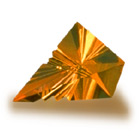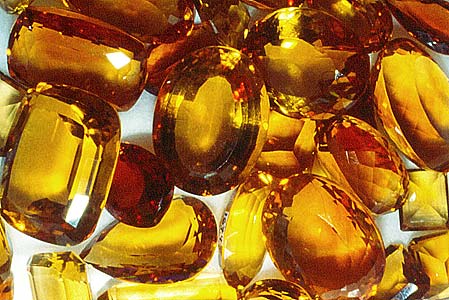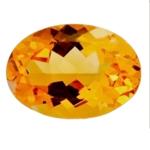Citrine was prized by the ancient Greeks and said to calm the mind, help achieve goals, enhance intuition and creativity, and provide protection from negativity.
 Glowing citrine is often mistaken for topaz, yellow sapphire, or yellow diamond. Its clear yellow color is said to bring joy, abundance, and protection from negativity, and the gem was prized. Citrine is one of the birthstones for the month of November and of the astrology sign Scorpio.
Glowing citrine is often mistaken for topaz, yellow sapphire, or yellow diamond. Its clear yellow color is said to bring joy, abundance, and protection from negativity, and the gem was prized. Citrine is one of the birthstones for the month of November and of the astrology sign Scorpio.
Yellow Citrine
Citrine is a form of quartz, colored with iron. The name citrine is derived from the French “citron,” meaning lemon, and citrine ranges from a buttery yellow to a deep amber orange. The more iron present in a citrine, the darker the color will be. Like many gemstones, dark citrine is worth more than paler yellow, even if the lighter stone is completely flawless.
Most of the citrine presently available is amethyst or smoky quartz that has been “burned” or heat-treated. This process was discovered in the 18th century to turn the quartz crystals from violet or grey to yellow.
The Citrine in History
The history of citrine is bound up with that of yellow topaz since the two stones can easily be mistaken for one another. Citrine is usually mistaken for (or misleadingly sold as) the more expensive topaz but both have been highly prized throughout Europe’s history. Citrine was worn as far back as the start of the Hellenistic period of ancient Greece, nearly two and a half millennia ago.

Citrine became popular once again in the 1930s and in the Art Deco movement between the First and Second World Wars.
Magical Significance and Powers of Citrine
Like most gemstones, citrines have been attributed with a long list of healing and magical powers. Citrine is said to:
- combat depression
- stimulate the body’s healing energies
- help manifest goals and attract abundance
- transmute and dissipate negativity and anxiety
- calm, soothe and clear the mind
- promote creativity and aid in problem-solving
- help connect with Spirit and with one’s inner guidance
- combat self-destructive tendencies
- symbolize hope, youth, and loyalty
Citrine Gemstone in Jewelry
Citrine is prized in jewelry for its glowing yellow color and is often used to replace the rarer yellow topaz or yellow diamond… sometimes legitimately and sometimes passed off by unscrupulous jewelers as topaz.
 Citrine is present in birthstone jewelry as one of the gemstones of November and the astrology sign Scorpio. (It is sometimes also suggested as an alternate gemstone for Virgo, given the high cost of sapphire.) Citrine is given as the traditional gem of the 13th wedding anniversary.
Citrine is present in birthstone jewelry as one of the gemstones of November and the astrology sign Scorpio. (It is sometimes also suggested as an alternate gemstone for Virgo, given the high cost of sapphire.) Citrine is given as the traditional gem of the 13th wedding anniversary.
Citrine is found in Spain, Scotland, France, Brazil, Uruguay, Hungary, Madagascar, the USA, and Russia. In fine jewelry, citrine is often combined with sapphires, peridot, amethyst, and/or garnet.
Reference
- All That Gifts, “Gemstones: Citrine,” All-That-Gifts.com, 2005.
- International Colored Gemstone Association, “Citrine,” Gemstone.org, 2009.
- Jewelry Mall, “Citrine,” JewelryMall.com, 2009.
